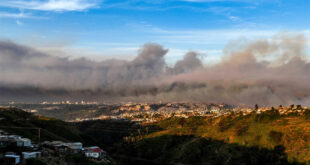Land in Ho Chi Minh City sinks by an average two to five centimeters a year, resulting in more frequent urban flooding, according to new study.
Vietnam’s largest city has constantly sunk since 1990, with the accumulated subsidence level until now estimated at 100 centimeters, Japan International Cooperation Agency (JICA) said in a new study conducted in collaboration with local state agencies.
Currently, the speed of subsidence averages two to five centimeters per year and in areas with concentrated high-rises, seven to eight centimeters per year.
According to the Division for Water Resources Planning and Investigation for the South of Vietnam, the city had sunk an average 23 centimeters from 2005 to 2017, though in An Lac Ward of Binh Tan District, it subsided by 81 centimeters.
Ten localities experiencing the worst subsidence include Districts 2, 7, 8, 12, Go Vap, Tan Binh, Binh Thanh, Phu Nhuan, Binh Tan and Thu Duc.
HCMC University of Technology (HCMUT) monitoring in 2006-2020 showed subsidence mostly took place in Districts 12, Go Vap, Tan Binh, Binh Thanh, Phu Nhuan and Binh Tan, with the highest rate recorded at 43 centimeters in 15 years, an average of three centimeters per year.
JICA conducted its research in conjunction with the Vietnam Institute of Geosciences and Mineral Resources, the Water Resource Institute under the Ministry of Natural Resources and Environment, and the Southern Institute of Water Resources Research under the Ministry of Agriculture and Rural Development and the Saigon Water Corporation (Sawaco).
The agency has proposed HCMC cope with subsidence based on the experiences of Jakarta and Tokyo.
The municipal departments of Natural Resources – Environment, Construction, Planning – Investment have been assigned to assist JICA in drawing up a subsidence response plan within the fourth quarter.
In 2019, Climate Central, a U.S.-based a nonprofit news organization that analyzes and reports on climate science, revealed that most of southern Vietnam, including the Mekong Delta and the nation’s economic hub HCMC could be flooded by 2050.
Sea levels would increase by one meter by 2100 and potentially flood about 18 percent of HCMC and 39 percent of Mekong Delta, it said.
- Reduce Hair Loss with PURA D’OR Gold Label Shampoo
- Castor Oil Has Made a “Huge” Difference With Hair and Brow Growth
- Excessive hair loss in men: Signs of illness that cannot be subjective
- Dịch Vụ SEO Website ở Los Angeles, CA: đưa trang web doanh nghiệp bạn lên top Google
- Nails Salon Sierra Madre
 VnExpress News The News Gateway of Vietnam
VnExpress News The News Gateway of Vietnam




